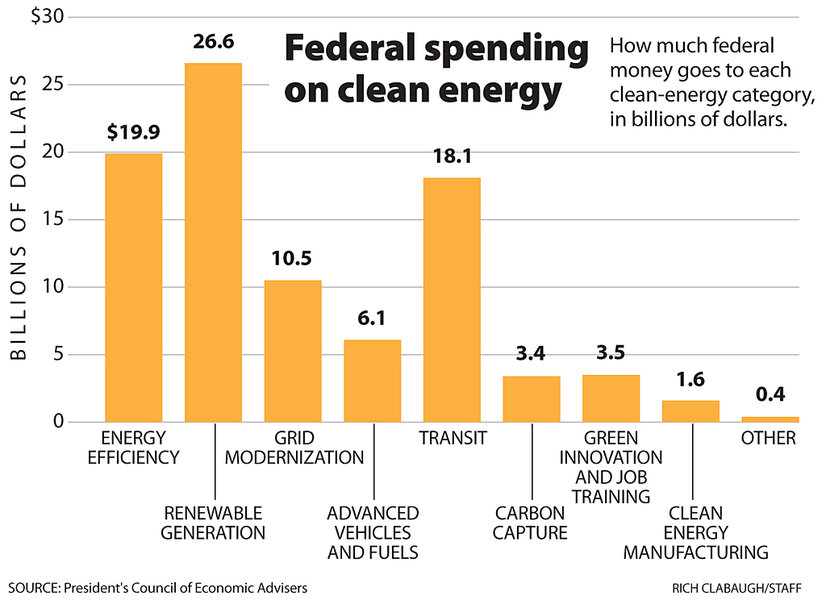Stimulus funds for clean energy largely unspent
Loading...
Making a “tremendous down payment on the clean energy transformation” of the United States was a top priority of the Obama administration’s economic stimulus package – but, despite some notable accomplishments, it remains mostly a promise at this point.
Most of the funds from the stimulus still haven’t been spent, and the clean-energy down payment is a long way from being completed. Its impact so far on those jobs has only been lightly felt in pockets across the nation, economists and others watching its impact in their regions say.
“It’s fair to say the stimulus is a down payment, but I wouldn’t call it a tremendous down payment at this point,” says Joan Fitzgerald, an expert on economic development at Northeastern University in Boston, who has analyzed the stimulus’s impact on the wind-power and other clean-technology industries.
Overall, the American Recovery and Reinvestment Act, or stimulus bill, has seen $263 billion spent of the $787 billion available by the end of last year. As a result, the US economy is now employing about 1.5 million to 2 million more workers, the President's Council of Economic Advisors recently reported – and other independent economists agree.
But so far, just one-third of the roughly $90 billion ($60.7 billion in direct spending and $29.5 billion in tax incentives) targeting the clean-energy sector has actually hit the street – to fund wind-farm development, solar plants, battery factories, high-speed rail, and home weatherization, among many other projects.
As a result, just 63,000 of the jobs directly created or saved by the American Recovery and Reinvestment Act by the end of last year were clean-energy jobs, the president's economic council reports.
That so-far modest impact should become much more significant as the US Department of Energy ramps up its approval process and spends the remaining billions by September, David Sandalow, assistant secretary of energy for policy and international affairs, said at a press conference Wednesday.
Over the next two years, the $90 billion spent on clean energy is expected to create 720,000 job-years of employment. In addition to jobs, some 16,000 megawatts of wind, solar, geothermal, and other renewable energy capacity propelled by the stimulus will power about 4 to 5 million homes.
“Each one of [these jobs] is doing work made possible by the recovery act,” Mr. Sandalow said. “The recovery act has been crucial to unlocking financing” for new wind, solar, geothermal power projects.
High-speed rail construction in Wisconsin, new-generation plug-in hybrid vehicle battery factories in Detroit and wind farm turbines sprouting across the US landscape last year – all would not exist without the stimulus passed by Congress last year, other observers agree.
“Some folks on one end of the spectrum say the stimulus hasn’t done a darn thing,” says Rob Sargent, who tracks clean-energy for EnvironmentAmerica, a Washington-based advocacy group. “If you look around and see – it has led to investments in clean energy of a magnitude we’ve never seen.” Other expert watchers agree.
“Broadly speaking, the stimulus has helped an enormous amount,” says Alex Klein, research director for Emerging Energy Research, a market research company based in Cambridge, Mass. “Treasury grants have helped expedite wind development, manufacturing incentives have jump-started battery manufacturing – and kept wind and solar manufacturing in the US alive.”
The stimulus has expedited both project development and helped to build local supply chains, Mr. Klein says. But some note that the stimulus, while keeping the wind-power and other renewable industries from tanking in 2009, has not worked a miracle on US clean-energy manufacturers’ competitiveness.
“We’re not competitive yet with other clean-energy export nations,” says Kevin Book, managing partner with ClearView Partners, a Washington energy research and consulting firm. “There’s an argument to be made that we could become the next big manufacturer of clean tech, but we’re not the most compelling candidate right now. China and Germany are ahead of us."
News reports highlighting Texas wind-farm projects that purchased Japanese-made turbines – and others with plans to purchase turbines from China – have had congressmen throwing up their hands in protest.
So is Bob Lloyd, plant manager at Clipper Wind Power’s Waterloo, Iowa, manufacturing plant. His plant had layoffs a year ago and is still operating at less than half its capacity.
“We’re trying to build this product,” he says. “ 'Hey, we're paying taxes, and we don’t want to pay taxes to bring in foreign-made products' – that’s the feeling of folks around here.”
Clipper and General Electric are America’s only domestic wind-turbine manufacturers. But while Clipper’s business is picking up, their plight highlights a conundrum: Until US demand for clean energy grows, it will be hard to develop domestic clean-energy manufacturing that can out-compete overseas companies on price as well as quality, experts say.
The stimulus support can't produce an overnight transformation for US clean-energy manufacturers, Mr. Book says. What’s needed is a “natural demand” for clean-energy, or a “legislative demand.” And yet, a cap-and-trade climate bill that would do just that, by putting a price on carbon emissions from coal-fired power plants, is stalled in Congress.
“Unless natural demand for clean energy develops in the US – or it can become a competitive exporter to markets overseas, the spending won’t have succeeded,” he says. “We have to have a price on carbon.”
----
Follow us on Twitter.



